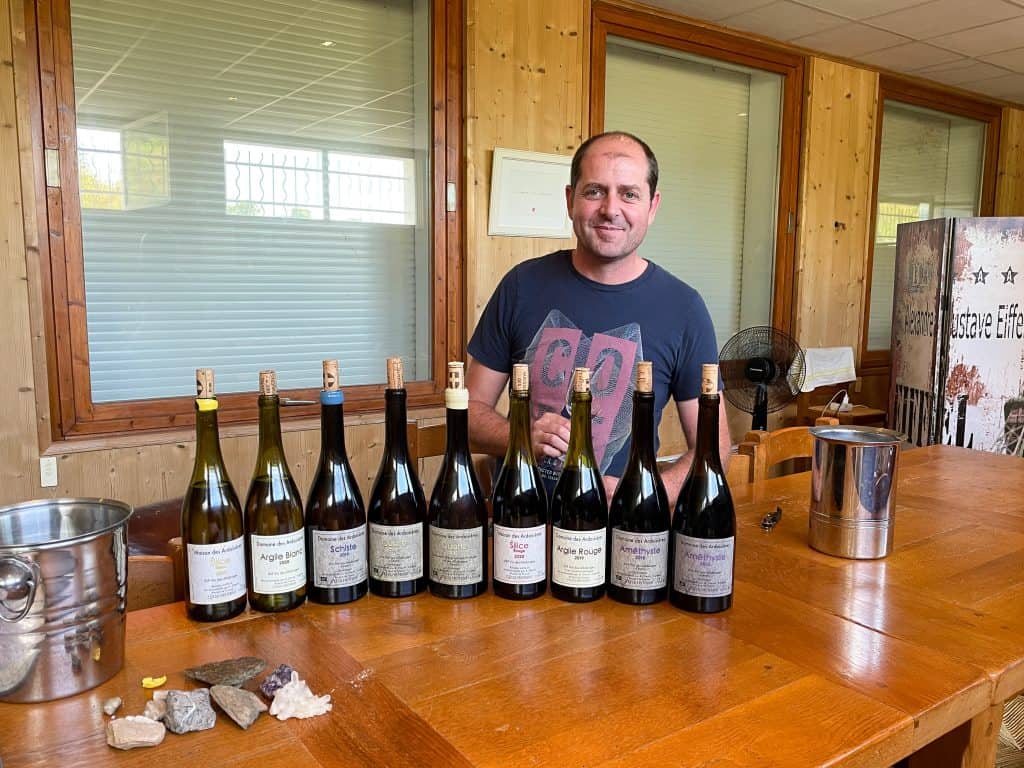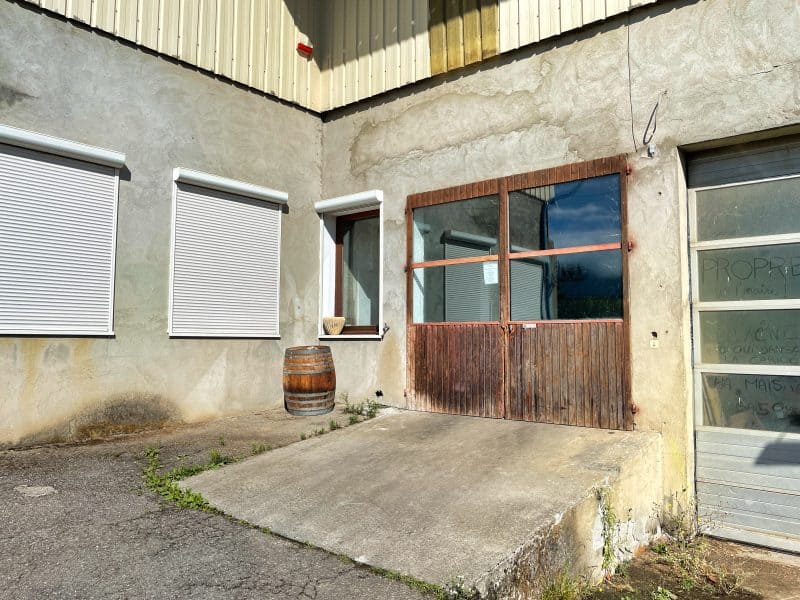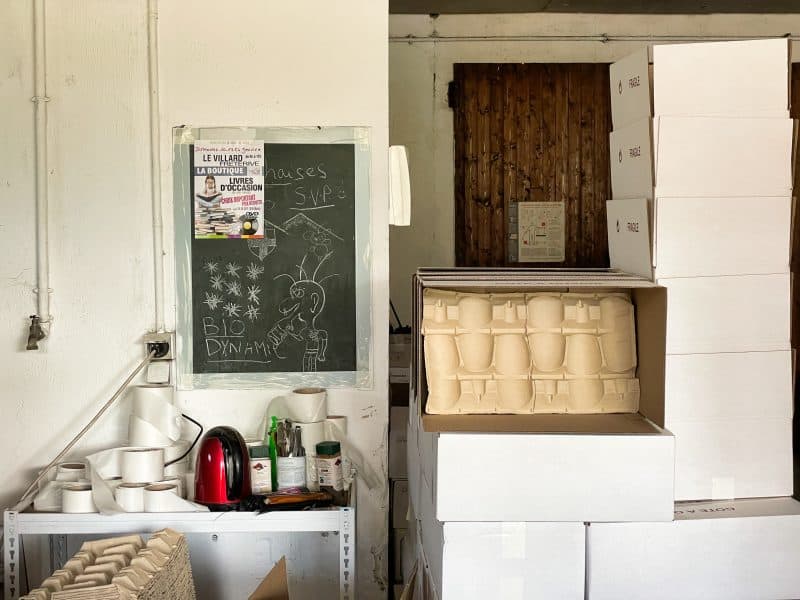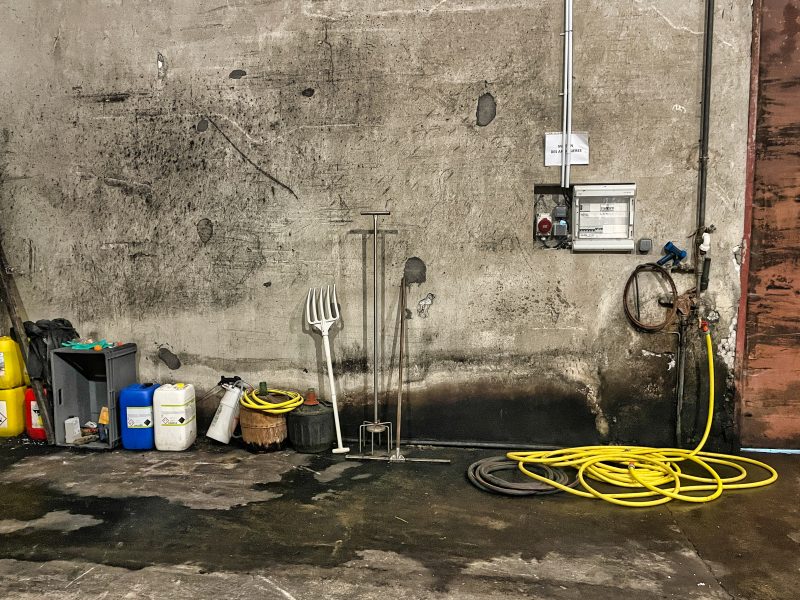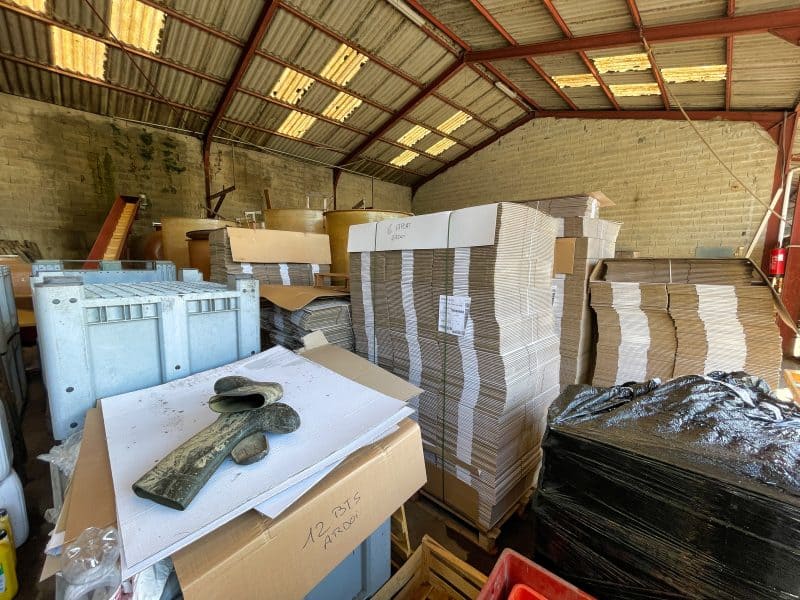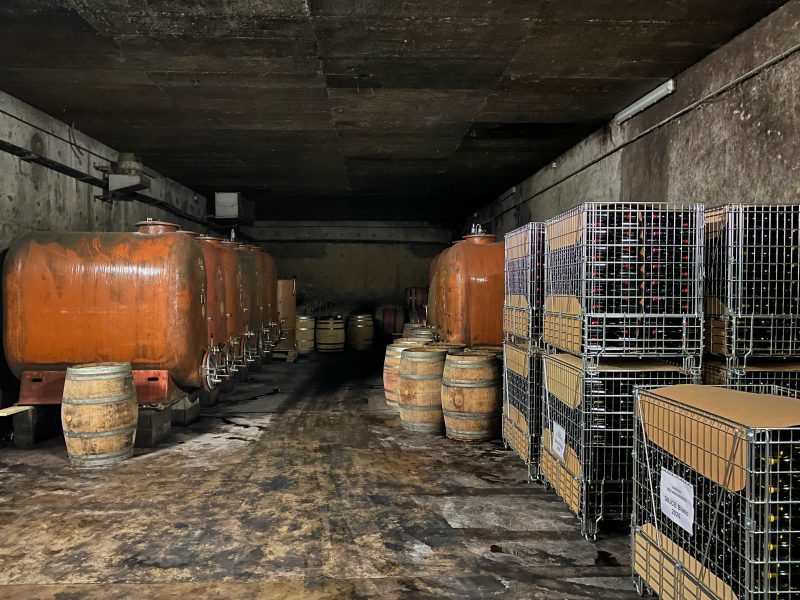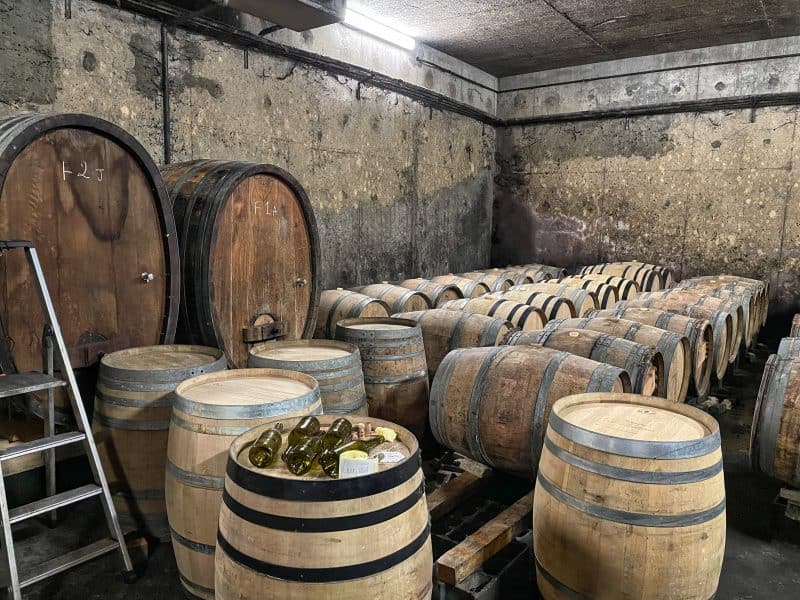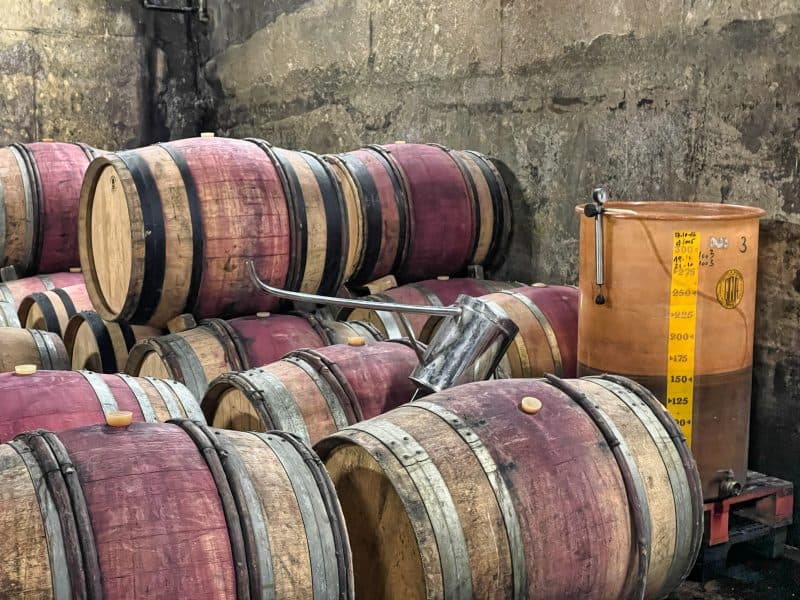Some truly great wines sneak up on you, sip after sip, taste after taste—deepening, resonating, and ultimately resolving into your own realization that you are experiencing something profound. More commonly in my experience, however, great wines hit you like a lightning bolt, with a silent detonation that snaps every iota of your attention to the wine itself.
That’s what it felt like the first time I tasted the wines of Domaine des Ardoisières, perhaps more than 10 years ago. I remember the moment well. I was sitting at a dinner table on the lawn at the International Pinot Noir Celebration in McMinnville, Oregon, and two seats away from me sat the famed importer Martine Saunier, to whom I had been introduced a few minutes before. As we settled into our table, Martine retrieved two bottles from her oversized handbag and plunked them on the table.
The labels intrigued me from the very start, with their slightly amateurish label design and funky fonts. At the time, I had no idea where they came from. IGP Vin des Allobroges meant nothing to me. “Where the hell is Allobroges?” I thought to myself. Eventually, our attendant sommelier came by and opened them up, and then, at my first sip, the heavens themselves opened up, and I was hopelessly smitten for life.
Yes, I am a sucker for wines that taste like liquid stone. And few wines in the world manage to taste and smell more like pulverized stone than these, which are unquestionably among the very best that are produced in the little region of France known as the Savoie.
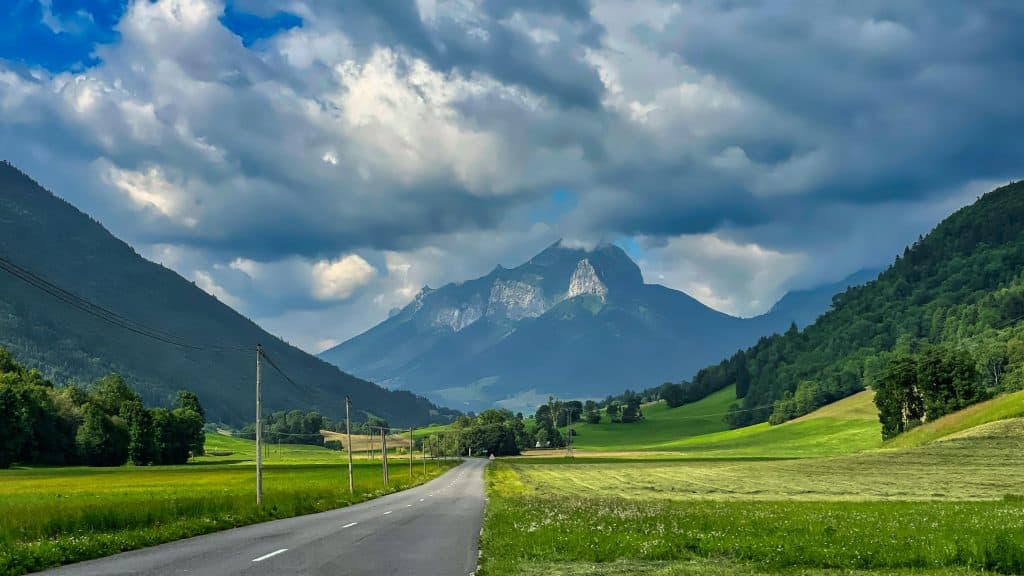
Nemesis of Ice
Few things can resist the power of a glacier that knows where it’s headed. When ten million tons of ice are headed your way, even at the creeping pace of a few centimeters per day, you get out of the way or you are ground to dust. Some of the world’s most spectacular u-shaped valleys are testament to this incredible power. Yosemite. The Fjords of Norway. Lauterbrunnen in Switzerland.
Occasionally, however, there are times when instead of obliterating, the ice embraces, flowing around and over a bit of stone instead of wreaking its slow pulverization.
Often, these snags or sills of stone will become the sites of recessional moraines, buildups of soil and glacial effluvia that are left behind as the ice melts and the glacier seems to retreat back up the valley it has carved towards the cirque of its birth.
The rivers of ice that carved the Tarentaise valley started their grinding about 2 million years ago, and finished their retreat only about 10,000 years ago, leaving behind the beautiful valleys of the French Alps, and stunning lakes such as Geneva and Annecy.
And in a place that would eventually be called Cevins, in an otherwise beautifully scoured u-shaped glacial valley, a small spur of solid schist gathered the stones and soil that the melting ice would no longer hold into a hill.
Over time, a village sprang up in the shadow of that hill, and the local residents, likely citizens of the Roman Empire at the time, planted grapes in the fractured schist soils. The vines were tended, some for better some for worse, and eventually, the townspeople placed a small chapel at the summit, dedicated to Notre Dame des Neiges, “Our Lady of the Snows.”
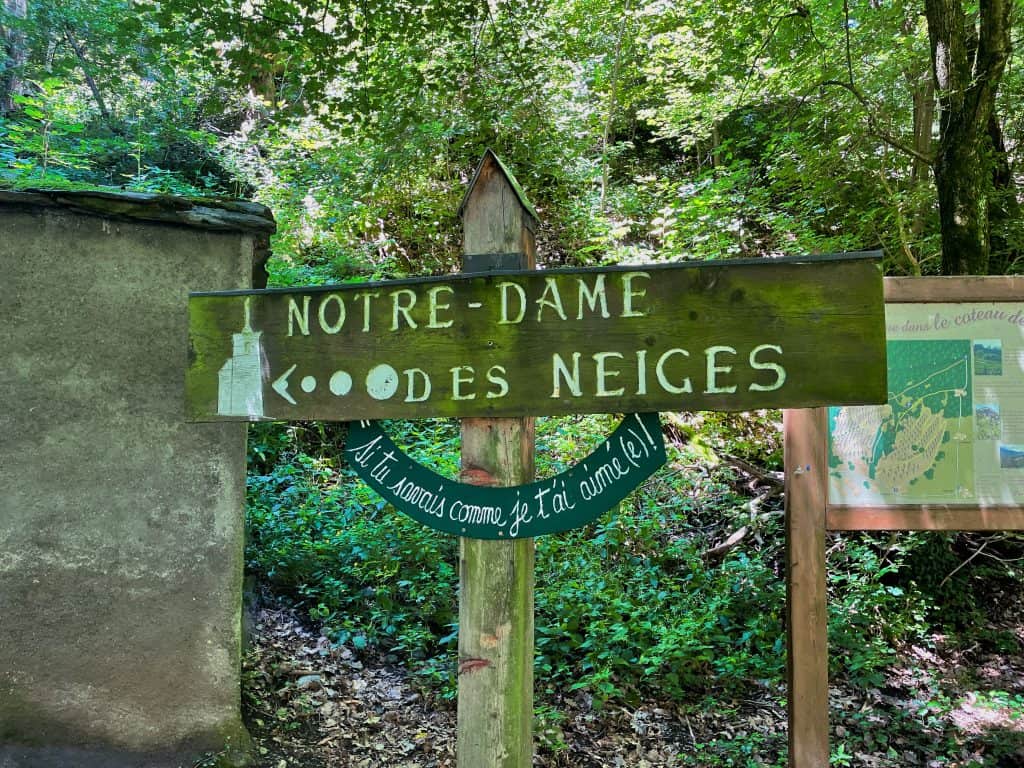
The Organic Visionary
Like many small-scale vignerons of his generation, Michel Grisard grew up on his family’s mixed farm, which produced wine as well as produce, eggs, and meats. The Grisard family, though, was perhaps a little deeper into wine than most, as they also ran a vine nursery, providing plants for new vineyards in their area.
After studying Agriculture at university, Grisard joined the family business only to have his father pass away a year later, leaving Michel to run the nursery and winery. Once joined by his brother in the family business, Grisard decided his future lay elsewhere, and in 1982 he left to work with the small acreage of Mondeuse Noire he had planted himself, renting the St-Christophe Priory in the village of Fréterive to use as a cellar.
Grisard’s approach to viticulture was quite traditional at first, in keeping with his university education, replete with herbicides, fungicides, pesticides, and fertilizers galore. However after meeting biodynamic consultant François Bouchet in 1994 through Michel Chapoutier, he quickly became the first biodynamic producer in the Savoie region and was certified organic three years later, and never looked back.
Soon after, thanks in part to having sold his wines to restaurant Paul Bocuse in Lyon, Grisard’s wines became quite sought-after.
As part of his explorations of nearby terroirs, Grisard eventually came across a tiny little town with a hillside full of derelict vineyards and crumbling stone terraces. The precarious slope over the little town of Cevins had been left out of the Savoie AOC region, in part because the narrow valley receives less sun than other areas of the region, and was thought to offer too much challenge in ripening grapes.
For Grisard, the unusual schist soils, steep southerly exposure, terraced plots, and a seemingly ancient history of wine growing were too much to resist.
Grisard created a company, solicited investment, bought or rented the majority of the land on the hillside, and between 1998 and 2002 he planted nearly 13 acres across the hillside with Mondeuse Noire, Persan, Altesse, Jacquère, Pinot Gris, and perhaps some of the region’s first plantings of the little known Mondeuse Blanche.
As the first plantings began to yield fruit, Grisard made the wines under his Prieuré St-Christophe label, but as this unique hillside matured, it became clear that it needed its own identity.
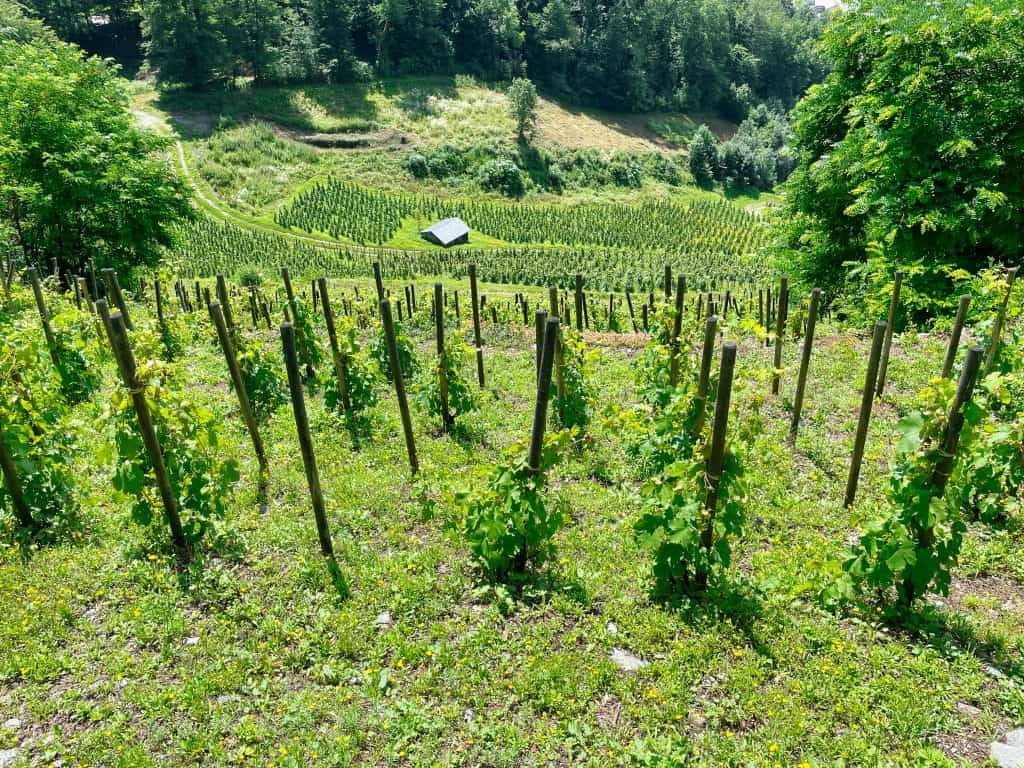
The End of a Journey, Beginning of a Calling
In the early 2000s, winemaker Brice Omont was working at a big production facility in Champagne, but while his hands were busy, his heart was somewhere else. He was both spiritually and literally searching for somewhere to make wine. He thought he might eventually end up in the Loire, given his interest in organic and biodynamic winemaking, but he made several trips to Anjou the surrounding areas and didn’t find what he was looking for.
Then some friends suggested he look at the Savoie. “I said ‘oh, you mean vin de raclette? I don’t think so,’” recalls Omont, referencing the Savoie’s (unfortunately still lingering) reputation for cheap, ski-resort swill. “I was prejudiced. But eventually, I took a vacation in 2003 and came to the region, thinking that I would just have a look.”
During his visit, he stopped off at the local Ministry of Agriculture office and explained that he was interested in organic winegrowing. “They said to me if that’s what you’re interested in, there is only one person for you to speak with. His name is Michel Grisard.”
“I called Michel Grisard and I visited,” continues Omont. “I tasted his wines and…” he shrugs. “Wow. The Mondeuse, the Altesse. I realized immediately the brilliance of his approach. His wines were superior to every Savoie wine I had ever tasted. So I talked with him, I told him I was looking for a place to make wine, and he told me that a young vigneron he had been working with had recently left.”
Grisard then went on to describe a small hillside of schist in the Tarentaise valley.
“I came back to Champagne, and I told myself, ‘This is it. It’s not the Loire, it’s the Savoie.’ And I knew that if I didn’t do this that I would regret it for the rest of my life.”
One week later, Omont was back in the Savoie, gazing up at the little hill of vines with a tiny white chapel at its summit.
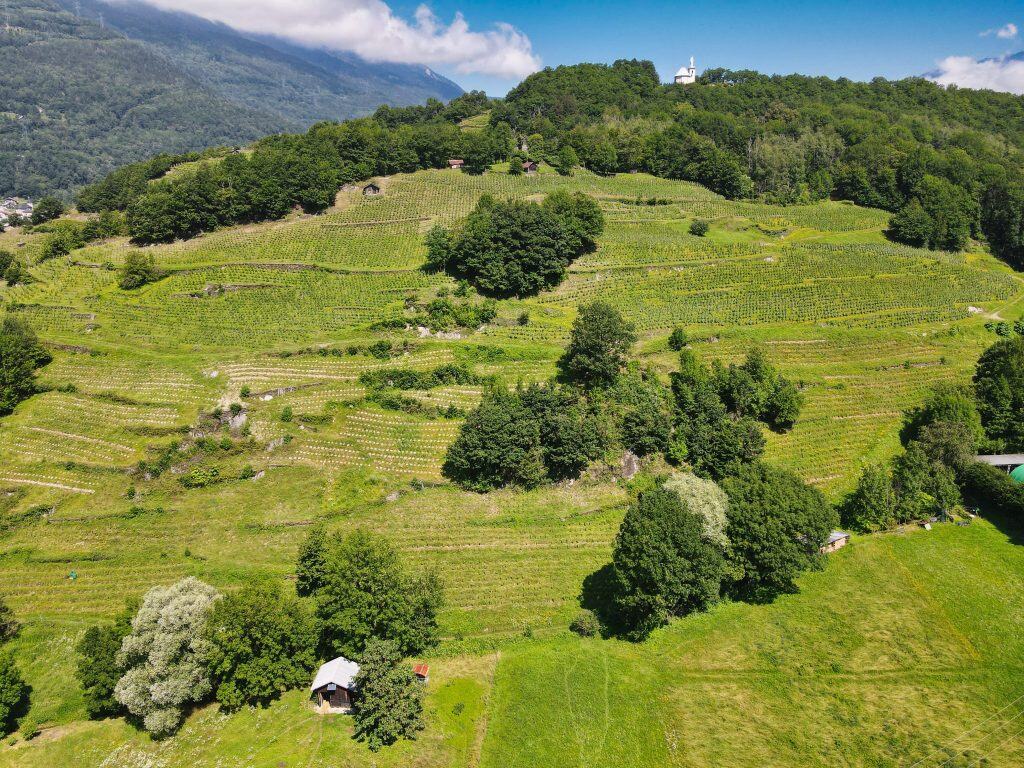
Ardoisières Against All Odds
“On my first day,” says Omont, “I thought that this was no problem. The second year I realized what kind of a hill it was that we had to climb. It was very high, and very difficult, and I wasn’t sure we were going to be able to do it. We didn’t have the means at our disposal to achieve our ambitions.”
The bank agreed. When Grisard and Omont went looking for more money, no one was willing to give them a loan. “I told Michel it was a shame, but it looked like we needed to win the lottery in order to make it work,” says Omont. “Three years later we were completely out of money.”
Omont describes calling their first and best customer and breaking the news that the banks had turned them down. “He said to me, ‘What is the plan?” And I told him we didn’t have one. That we were done.”
Click the images in the gallery below for larger views.
But that customer called 10 other customers—some retailers, some restaurateurs and some consumers—and as a group they came back to Omont and told him to open a bottle of wine, and when he did, they said they would collectively co-sign for a loan, and that they would all come to help whenever the winery needed a hand.
“I pinched myself because I couldn’t believe what was happening,” says Omont. “The bank did not understand, but these people did. They had a passion for wine. Many people told me we were crazy to do this, that we’d lose control and that these people would run everything. But these people wanted no salaries, no investment returns. They just said, ‘take your time, don’t worry, do it the best way. We are just happy to drink it. If you want to give us some bottles, we’ll be happy,’ but no more than that. It’s the opposite of this kind of jungle economics you hear about. There are times when you’re scared of humanity. And then there are times like that where you just shake your head and say, ‘Fantastic.’”
Most of the investors remained silent partners, but eventually, two became advisors to Omont and Grisard, helping them think through the structuring of a healthy business, to plan for expansion, and in 2010 helped them secure the somewhat ramshackle building with a rare underground cellar that Omont located in the village of Freterive,
Around this time, Omont and Grisard had a falling out, and Grisard, who would retire from winemaking altogether in 2014, stepped away, leaving Omont solely in charge.
Soon after Omont joined, the wines were given their own identity, named after the slate (ardoise) roofs of the small vineyard huts that dot the hillside.
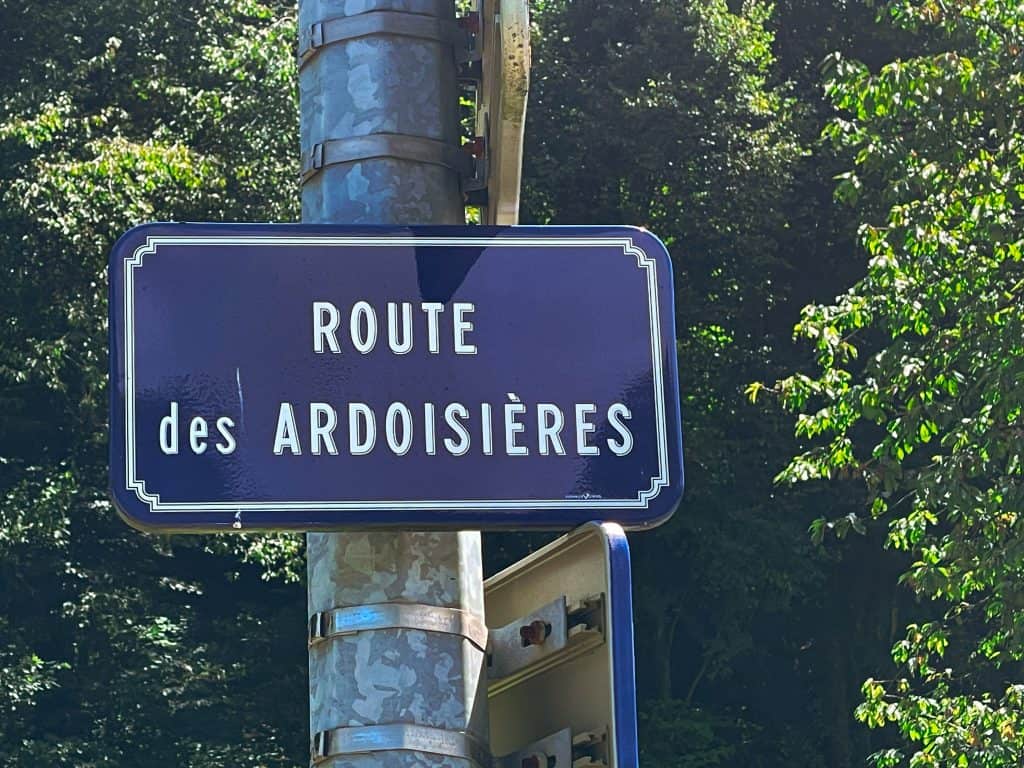
A Song of Schist and Clay
Domaine des Ardoisières farms 38.3 acres of vineyards located in two primary places, the fractured schist hill of Cevins and several plots surrounding the villages of St-Jean-de-la-Porte and St-Pierre-de-Soucy, which feature the typical Savoyard mix of clay and fractured limestone tumbled from the cliffs of the Combe de Savoie. From these two areas, the domaine has historically made five wines, named primarily for the soils in which they grow.
The Argile Blanc is a blend of Jacquère, Mondeuse Blanche, and Chardonnay farmed from 4 different locations around the village of St-Pierre-de-Soucy, some of which include some schist in addition to limestone. Some newly acquired vineyard plots that include some Roussanne plantings mean that a fourth grape may soon join the blend.
Its red counterpart, Argile Rouge, is mostly Gamay, with Mondeuse Noire and Persan, and comes mostly from around St-Jean-de-la-Porte.
The Schiste white wine, an unusual blend of Jacquère, Roussanne, Pinot Gris, and Mondeuse Blanche comes from the hill at Cevins, as does the 100% Altesse wine named Quartz.
The red blend named Amethyste is also overseen by Our Lady of the Snows, and features a blend of Mondeuse Noire and Persan.

The simplicity of winemaking at Domaine des Ardoisières will come as no surprise to fans of biodynamic and organic wines. Harvests by hand proceed slowly, and the variety of exposures across his sites means that a month or more can pass between the first grapes harvested and the last.
I thought wines that were so good meant I had to know a thousand things to get them right. But in the end it’s just easy. You just have to take care of your grapes.
Omont uses whole clusters, presses the wines gently, and ferments with ambient yeasts, adding no sulfur until just before bottling. If the wines take 3 months or even 6 months to finish their fermentation, Omont is happy to let them do their thing. Malolactic conversion occurs naturally, and the wines age in steel and enamel tanks or in used oak barrels. After the 2004 vintage didn’t go through malolactic, Omont has worked to reduce his use of sulfur to a minimum.
“I take my time. You have to let fermentation construct the layers of aromas in the wine. And the wines need time,” says Omont. “In the end, it is not complicated. When I started I told Michel that I wanted to do pump-overs. ‘No,’ he said. ‘Let it go.’ I thought wines that were so good meant I had to know a thousand things to get them right. But in the end, it’s just easy. You just have to take care of your grapes.”
Omont farms without pesticides or herbicides, applying compost to the vines, occasionally some copper and sulfur, and some (though not all) of the biodynamic preparations, choosing to pay more attention to his vines than any particular regimen of treatment.
But no matter how well he cares for his vines, there’s one thing Omont can’t control.
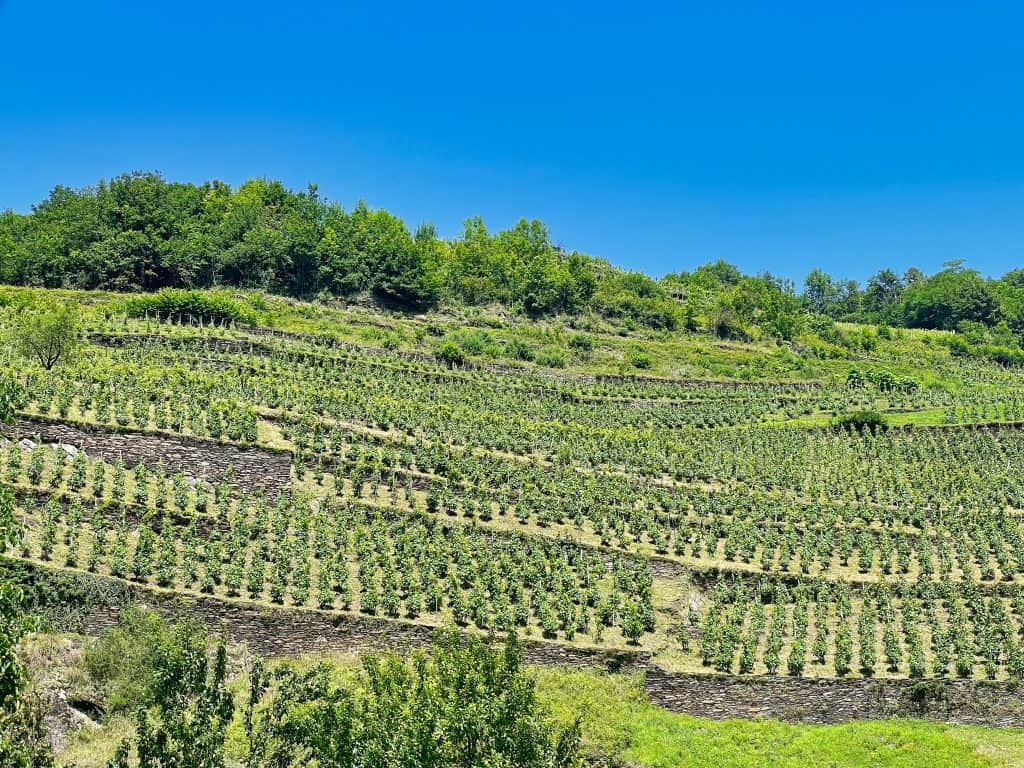
Climate Insurance
“Ten years ago, we had nine good years, and then one bad year,” says Omont. “Since 2018, we have had one bad, one good, one bad.”
Indeed, the week before I arrived in the Savoie in mid-July, the region had been hit by serious rainstorms, not to mention some frost in the spring, leading Omont and many vintners to estimate mildew-driven crop losses approaching 50%.
“We need to make sure that if I invest to make improvements to the building, and if we continue to sell our wines overseas, that we are OK. If tomorrow we lose 80% of our production, we are dead,” says Omont. “We have to prepare for the worst.”
In formulating his strategy for climate survival, Omont took inspiration from some winemakers in the Jura, where he saw small established players going to other parts of their region and leasing vineyards as a hedge against weather calamities.
“In the next ten years, we will for sure have more difficulties,” says Omont, “so I am preparing now to make more stock.”
In 2018, Omont debuted a Jacquère named Silice Blanc, and in 2020, he made a Silice Rouge from Mondeuse Noire. Both are labeled with the name “Maison des Ardoisières” and are made with grapes purchased from organically farmed vineyards that Omont has identified and contracted around the Savoie.
As the wines of Ardoisières have seen increased demand, these new wines are an attractive proposition that allows more people to try Omont’s wines, but without him feeling like he is sacrificing quality for the sake of commercial scale.
More importantly, the diversification of his vineyard sites has already proved out Omont’s strategy. “With this year’s rain and frost, we’d be dead without Maison des Ardoisières.”
Custodian of a Voice
At 45 years old, and with just over 17 harvests at Ardoisières, Omont is in the prime of his winemaking career, and the wines reflect his confidence and the understanding of both the grapes and the sites he has to work with.
One day I will die, and this terroir will continue. Have I listened correctly to the terroir? Have I expressed correctly the terroir? I am lucky enough to have the chance to do that.
“My biggest regret is that we didn’t build a library of these wines,” he says. “I know these wines will last 10 or 15 years or more, but at the beginning, I had no choice. When someone called and asked for more bottles, I was happy to help them.”
Altesse in particular, says Omont, has the capacity not only to age but to develop and improve with time. Like Riesling, Semillon, Assyrtiko, or Catarratto, Altesse begins with chiseled acidity and deep stony qualities, but it gains a fleshy weight and an attractive buttery, saline richness over time, undergoing a transmutation that seems almost magical.
Persan and to a lesser extent, Mondeuse Noire, also have the ability to develop attractive secondary and tertiary characteristics with age. “People say Persan ages like Pinot, and Mondeuse ages like Syrah,” says Omont.
Eventually, perhaps, Ardoisières will be able to hold some bottles back, but with a production of only a few hundred cases for its top wines, that will be slow going.
In the meantime, Omont seems content with his progress, and quite comfortable with the direction he is headed.
“We are just messengers,” says Omont. “One day I will die, and this terror will continue. Have I listened correctly to the terroir? Have I expressed correctly the terroir? I am lucky enough to have the chance to do that. Each vintage, I ask myself, did I do a good job expressing what this place has to say?”
For those of us who love to hear the whispers of magical places and taste the majesty of a landscape in the glass, the answer is an unqualified yes.
* * *
I am particularly indebted to Wink Lorch and her tremendous book Wines of the French Alps for some of the background information about Michel Grisard that I have included above.
Tasting Notes
In case it is not obvious from the above, or the scores below, these are some of my absolute favorite wines in the world, and (at the risk of making them harder to get for myself) they come with my highest recommendation. They are imported by Martine’s Wines.
2020 Maison des Ardoisières “Silice Blanc” Jacquère, IGP Vin des Allobroges, France
Palest gold in the glass with almost no color, this wine smells of green apples and grapefruit pith. In the mouth, green apple, grapefruit, and a hint of white flowers are bright and juicy with fantastic acidity. Great wet chalkboard minerality. These grapes come from the limestone studded soils of Apremont. 11% alcohol. Score: around 9. Cost: $26. click to buy.
2020 Domaine des Ardoisières “Argile Blanc” White Blend, IGP Vin des Allobroges, France
Palest greenish gold in the glass, this wine smells of green apples, wet stones, and white flowers. In the mouth, deep stony flavors of green apples, white flowers, and citrus pith are welded to wet pavement. Incredibly stony and delicious. A blend of Jacquère, Mondeuse Blanc, and Chardonnay. Comes from 4 locations around the village of Saint Pierre de Soucy which feature limestone studded clays referenced by the wine’s name. 11.5% alcohol. Score: between 9 and 9.5. Cost: $45. click to buy.
2019 Domaine des Ardoisières “Schiste” White Blend, IGP Vin des Allobroges, France
Pale gold in the glass, this wine smells of star fruit and a bit of unripe greengage plums, and wet chalkboard. In the mouth, gorgeous star fruit, wet chalkboard, lime flower, and lime zest flavors are wonderfully mouthwatering with faint salinity. Mouthwatering and stunningly mineral. Like drinking stone. Comes from the vineyard on the hill below the Our Lady of the Snows chapel, along the Rue des Ardoisiers in Cevins. A blend of Jacquère, Roussanne, Pinot Gris, and Mondeuse Blanche. 12% alcohol. Score: around 9.5. Cost: $60. click to buy.
2019 Domaine des Ardoisières “Quartz” Altesse, IGP Vin des Allobroges, France
Light greenish gold in the glass, this wine smells of citrus pith, warm hay, dried herbs, and wet chalkboard. In the mouth, grapefruit pith, dried herbs, and wet stones swirl in a wonderfully deep stony cistern of flavor and mineral expression. The crushed rock quality continues in the finish with some pithiness and a hint of lemongrass. These Altesse grapes are also from the Cevins vineyard. 12.5% alcohol. Score: around 9.5. Cost: $120. click to buy.
2012 Domaine des Ardoisières “Quartz” Altesse, IGP Vin des Allobroges, France
Pale gold in the glass, this wine smells of melted butter and wet chalkboard. In the mouth, saline flavors of lemon oil, wet pavement, and seawater take on a shimmering ethereal quality that is simply and irresistibly mouthwatering. Rich on the one hand, and then also light and zingy on the other, this wine is utterly compelling. This bottle demonstrates what happens to Altesse with some age: it fattens up and to the searing liquid stone minerality it adds a layered buttery caramel quality. Boom. 12.5% alcohol. Score: between 9.5 and 10. Cost: $120. If you can find it, buy it.
2020 Maison des Ardoisières “Silice Rouge” Mondeuse Noire, IGP Vin des Allobroges, France
Light to medium garnet in the glass, this wine smells of boysenberry and aromatic herbs like lavender and pennyroyal. In the mouth, stony bright flavors of boysenberry and dried sage are suffused with a cloud of powdery tannins that fill the mouth and leave a chalk-dust minerality lingering on the palate. Fantastic acidity. This is the only wine at Ardoisiers that is destemmed. After a week of maceration, this wine is fermented and aged in steel tanks. 10.5% alcohol. Score: between 8.5 and 9. Cost: $30. click to buy.
2019 Domaine des Ardoisières “Argile Rouge” Red Blend, IGP Vin des Allobroges, France
Light garnet in the glass, this wine smells of berries and bramble, green herbs, and a hint of sawdust. In the mouth, gorgeously bright acidity makes flavors of mulberries, redcurrant, and plum mix with the faint bitter sourness of plum skin. Wonderful tangy flavors and faint herbal notes are welded to wet pavement minerality and a long finish. Whole bunches of 65% Gamay, 25% Mondeuse Noire, and 10% Persan macerate for 10 days before fermentation. Ages in large oak foudres for about 9 months before bottling, and then released the following year. 11.5% alcohol. Score: between 9 and 9.5. Cost: $45. click to buy.
2018 Domaine des Ardoisières “Amethyste” Red Blend, IGP Vin des Allobroges, France
Light to medium garnet in the glass, this wine smells of mulberries, and aromatic green herbs. In the mouth, saline flavors of mulberries, sour cherry, and herbs swirl and crackle with phenomenal acidity and stony minerality, with the saline notes making for a mouthwatering finish for minutes. Incredibly delicious. Stony faint tannins. A blend of Persan and Mondeuse Noire that I could drink all day long. 11% alcohol. Score: around 9.5. Cost: $105. click to buy.
2016 Domaine des Ardoisières “Amethyste” Red Blend, IGP Vin des Allobroges, France
Light garnet in the glass, this wine smells of dried sage and other herbs with sour cherry, mulberry, and dusty road notes. In the mouth, deeply mineral flavors come through a haze of chalk-dusty tannins and a core of sour cherry and mulberry fruit tinged with hints of citrus peel crackles with mouthwatering acidity. Wonderfully long, juicy finish. Outstanding. 12% alcohol. Score: around 9.5. Cost: $105. click to buy.
